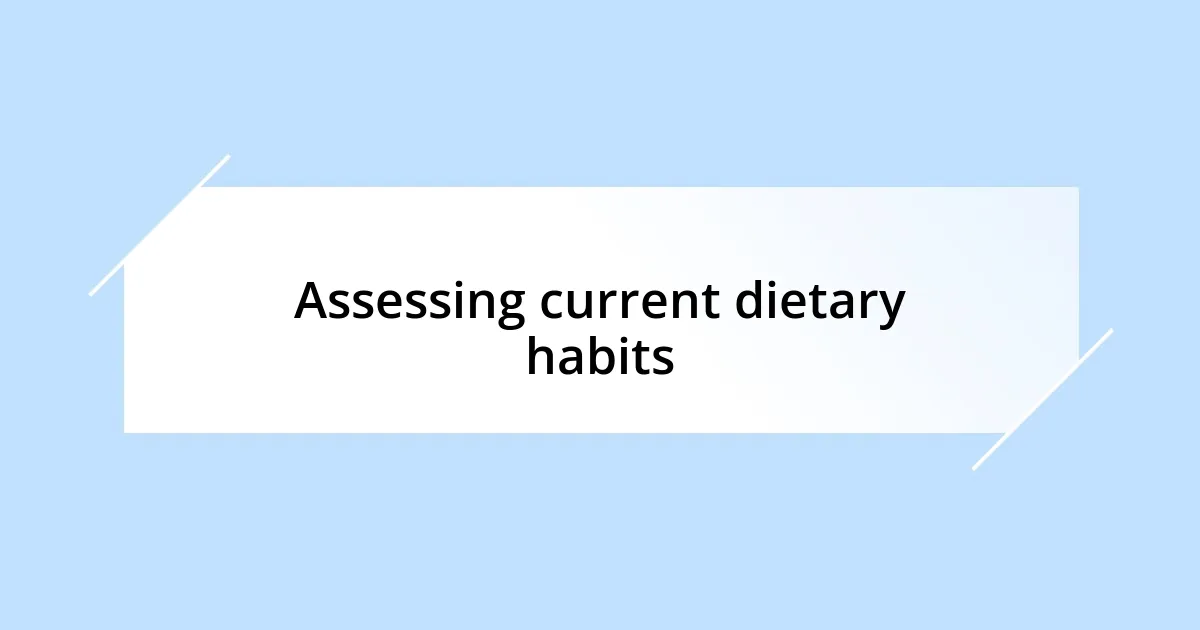Key takeaways:
- The realization of health issues, such as rising cholesterol, can serve as a wake-up call to reassess dietary habits.
- Setting specific, measurable nutrition goals enhances accountability and motivation, making it easier to adopt healthier eating practices.
- Incorporating whole foods and managing portion sizes can significantly improve one’s health and satisfaction with meals.
- Establishing a consistent routine and allowing for forgiveness in dietary choices fosters long-term success and balance.

Understanding the need for change
Recognizing the need for change often stems from a moment of realization. For me, it was during a routine check-up when the doctor cautioned me about my rising cholesterol levels. That stark reminder felt like a wake-up call. Have you ever found yourself in similar circumstances, where numbers don’t lie and the consequences start to feel all too real?
I remember feeling overwhelmed by the thought of overhauling my entire diet, but deep down, I knew it was essential for my health and well-being. I wondered, how could I continue to live the life I loved if I didn’t take control of what fueled me? This contemplation lit a fire within me, motivating me to explore healthier choices instead of fearing the change.
Understanding the need for dietary change isn’t solely about the numbers; it’s also about valuing my health in a more profound way. Embracing this journey transformed my perspective on food as nourishment rather than just a convenience. Has your relationship with food ever shifted after an eye-opening experience? Such introspections often reveal that every meal can be an opportunity for better health, linking our food choices to personal growth.

Assessing current dietary habits
Assessing my current dietary habits was a bit like peering into a mirror that had been smeared with grease. I couldn’t ignore it any longer. I took a week to jot down everything I consumed, from the hearty breakfast to those late-night snacks that I often pretended didn’t count. This exercise opened my eyes to patterns I wasn’t fully aware of—like how often I reached for processed snacks instead of real fruits or veggies. Can you relate to the feeling of realizing that your habits might not align with your health goals?
Identifying what I truly ate helped me pinpoint the culprits that sabotaged my healthier intentions. For instance, I noticed that convenience often dictated my choices. I was surprised to find that my lunch was frequently a hurried sandwich from a store instead of a homemade salad bursting with colors. It’s crucial to recognize these small yet significant choices. After all, each meal is a vote for the kind of health I aspire to achieve. Do you take time to reflect on what you eat during a typical day?
Through this self-assessment, I began to understand my emotional triggers tied to food. Those afternoons when my energy dipped led me straight to sugary snacks—something I hadn’t considered before. It was revealing to realize that some of my eating habits stemmed from stress or boredom rather than hunger. By acknowledging these patterns, I was able to make more intentional choices that aligned with my health goals. Have you ever paused to ask yourself what drives your food decisions?
| Habit | Assessment |
|---|---|
| Meals at Home | Often overlooked, I was primarily eating takeout or pre-packaged meals. |
| Snacking | Packed with convenience foods, I realized I wasn’t fueling my body wisely. |
| Portion Sizes | I had larger portions than necessary, affecting my digestion and energy levels. |
| Mindless Eating | Scrolling through my phone during meals led to distracted eating. |

Setting clear nutrition goals
Setting clear nutrition goals was a game-changer for me. Initially, I stumbled through vague ideas like “eat healthier” without much clarity. However, when I began to outline specific, achievable goals, everything shifted. I remember setting my sights on incorporating more plant-based meals into my week. By aiming for three vegetarian dinners, I noticed not only a boost in my energy levels but also a newfound excitement about cooking. Have you ever felt the thrill of working toward a tangible goal?
To streamline your approach, consider creating SMART goals, which stand for Specific, Measurable, Achievable, Relevant, and Time-bound. Here’s how I broke it down for myself:
- Specific: I chose to include more fruits and vegetables in each meal.
- Measurable: I aimed for five servings of veggies daily, making this a clear target to hit.
- Achievable: Preparing meal plans on Sundays helped me stick to my plan, without feeling overwhelmed.
- Relevant: It aligned with my desire to manage cholesterol and improve overall wellness.
- Time-bound: I committed to this for three months to establish lasting habits before reassessing my progress.
You see, clarity on my nutrition goals didn’t just help in tracking progress; it became a motivating force driving my daily choices. More importantly, it made me feel empowered, a far cry from the confusion that once surrounded my eating habits.

Incorporating whole foods into meals
Incorporating whole foods into my meals felt like finding hidden gems amid a sea of processed options. I started small, swapping out refined grains for quinoa and brown rice. The first time I prepared a colorful stir-fry with vibrant peppers, broccoli, and chickpeas, I felt a surge of pride. I remember thinking, “Wow, not only does this look fantastic, but I can also taste the freshness.” Have you ever realized how much more satisfying a home-cooked meal can be when it’s packed with whole foods?
As I explored this journey, I found diverse ways to include whole foods in daily meals. For breakfast, oatmeal topped with fresh berries became my go-to. I discovered that not only was it delicious, but it also kickstarted my day with lasting energy. I once hesitated to make oatmeal because I thought it was bland, but adding a sprinkle of cinnamon transformed it into something special. Have you explored simple tweaks to elevate your morning routine?
One of the most delightful surprises was snacking on whole foods. Instead of reaching for chips, I opted for carrot sticks and hummus, instantly feeling more refreshed and full. I vividly recall the first time I made my own trail mix—just a blend of nuts, seeds, and dried fruit. It was empowering to realize that with a bit of preparation, I could create satisfying snacks that fueled my body. Have you tried substituting your favorite guilty pleasures with a nourishing alternative? Each time I chose whole foods, I not only nourished my body, but also cultivated a deeper appreciation for the ingredients I was using.

Managing portion sizes effectively
Managing portion sizes effectively became a pivotal part of my health transformation. I can still recall my early dinners where I’d fill my plate to the brim, thinking that more food equated to more satisfaction. One day, I decided to try using smaller plates, and it changed everything. Suddenly, my meals looked plentiful without overwhelming my senses. Have you noticed how the size of your plate can influence your perception of fullness?
I also learned to listen to my body’s hunger cues, prioritizing quality over quantity. During one memorable evening, I was caught up in a great conversation and lost track of how much I had eaten. Instead of mindlessly reaching for seconds, I paused to assess my fullness. That moment taught me that slowing down during meals allowed me to truly enjoy the flavors while honoring my body’s signals. Do you often find yourself eating without paying attention to how you feel?
Moreover, I embraced the idea of portion control by prepping meals in advance. On one particular Sunday, I dedicated a few hours to batch cooking for the week. I prepared just the right portions of grains, proteins, and vegetables, filling containers that I could reach for throughout the week. It not only saved time but also helped me avoid overeating during busy days. Isn’t it reassuring to know that with a bit of planning, you can take control of your diet in such a meaningful way?

Overcoming common dietary challenges
One of the biggest dietary challenges I faced was overcoming cravings for my old comfort foods. I remember one particularly tough evening when the smell of pizza wafted through my neighborhood. Instead of succumbing to those cravings, I got creative in the kitchen. I made a cauliflower crust topped with tomato sauce and loads of veggies, and to my surprise, it satisfied my craving without weighing me down. Have you ever found a healthier alternative that surprised you?
Another hurdle was social situations. I can’t forget my friend’s birthday party when I walked in, and a table brimming with sugary treats greeted me. I felt that familiar tug to indulge, but I reminded myself of my goals. I focused on enjoying the company and opted for a fresh fruit platter, finding joy in the vibrant flavors while everyone else indulged. Isn’t it fascinating how shifting your focus can change your experience?
Meal prepping was another game-changer in my journey. In the beginning, I found it hard to stay consistent with healthy eating during busy workweeks. Then one Saturday, I carved out a few hours to prepare meals for the upcoming days. As I packed colorful containers of quinoa salads and roasted veggies, I felt a sense of accomplishment. It was an empowering realization that I was setting myself up for success, eliminating the temptation of last-minute takeout. Have you tried making meal prep a part of your routine for greater peace of mind?

Maintaining long term dietary success
To maintain long-term dietary success, I found that establishing a routine was crucial. I made it a point to sit down for meals at the same times each day, creating a rhythm in my eating habits. This structure not only helped regulate my hunger levels but also made me more mindful of what I was consuming. Have you ever noticed how a routine can simplify your choices?
Another key element for me was variety. At first, I gravitated towards a few staple meals, thinking they were the easiest to prepare. However, as I explored new recipes and ingredients, I discovered that excitement in my diet kept me engaged. One weekend, I attempted a new dish featuring chickpeas and spices I had never tried before, transforming a simple meal into an adventure. How often do you challenge yourself to try something new in the kitchen?
Lastly, I learned the importance of forgiveness. There were days when I slipped back into old habits or indulged too much. Instead of beating myself up, I chose to reflect on those moments positively. I recall a night where I overindulged at a restaurant, but instead of punishing myself, I used it as a learning experience. Recognizing that it’s okay to have a treat now and then helped me to cultivate a more sustainable, balanced approach to my diet. Isn’t it freeing to know that perfection isn’t necessary for success?














